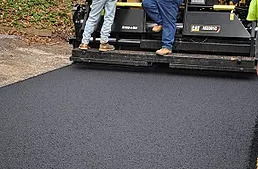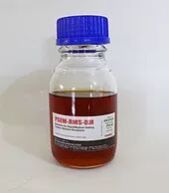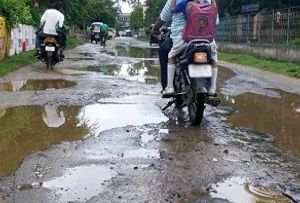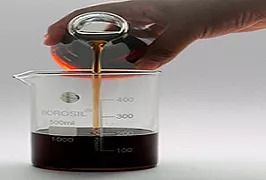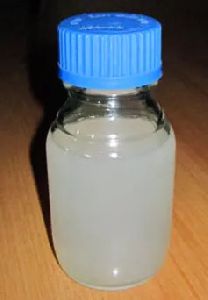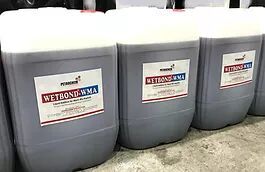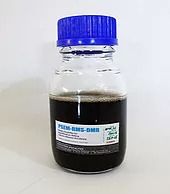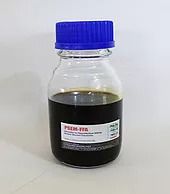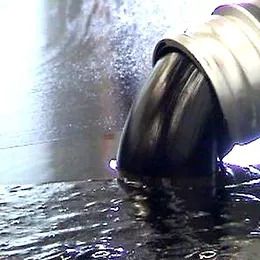- GST NO. : 09AGSPA6716B1ZI
View Mobile Number
| Business Type | Manufacturer, Exporter |
| Feature | Highly Effective, Safe Usage |
| Grade Standard | Chemical Grade |
| Country of Origin | India |
| Click to view more | |
Product Details
Our products are tested from :
- Central Road Research Institute, New Delhi.
- IIT - Roorkee.
- Indian Institute of Petroleum, Dehradun
- CEG Test Lab & Research Center, Jaipur
- Delhi Test House, Delhi
- Shriram Institute of Industrial Research, Delhi
- U.P.P.W.D. Research Institute, Lucknow. and many more...
Common tests for on-site evaluation of the efficacy of Anti-stripping Agents are :
- Coating Retention Test : A test similar to stripping test where the blends of different doses of Anti-stripping Agents (0.0, 0.2, 0.4, 0.6, 0.8 and 1.0%) in hot Bitumen are prepared and 10 gms of each blend is mixed with 200 gm hot aggregates and placed in a beaker to cool. Each beaker is then filled with distilled water to submerge the aggregates and placed in water bath maintained at 40°C for 24 hrs. After 24 hrs, each beaker is visually inspected to determine the percentage of Anti-stripping Agent sufficient to retain more than 95% coating.
- Under Water Coating Test : Different blends of Anti-stripping Agents (0.0, 0.2, 0.4, 0.6, 0.8 and 1.0%) are made in bitumen cutback MC-30. In a 1-litre capacity tin container, 200 gm aggregate are taken and 750 ml of warm distilled water (at 40°C) is poured inside. On top of water, 10 gm of bitumen-antistripping blend is poured. The container is then capped and shaken vigorously for 2 minutes. Then water is drained out and aggregates are transferred on white paper. Percentage of area of aggregates coated with bitumen inside water is then visually estimated.
- Boiling Test : Blends of different doses of Anti-stripping Agents (0.0, 0.2, 0.4, 0.6, 0.8 and 1.0%) in Bitumen are prepared and each mixed in 10 gm quantity with 200gm aggregates and put in a beaker to cool. Each beaker is then filled with distilled water to submerge the aggregates and boiled vigorously for 10 min. After 10 min water is drained and the aggregates are transferred to white paper where retained coating is visually estimated.
- Retained Marshall Stability : Test specimens are prepared with 5% Bitumen/ Bitumen-Antistripping Agent blends. One group is placed in water at 60°C for 40 min and tested for Marshall Stability. The other identical group is immersed in water at 60°C for 24 hrs. and then tested for Marshall Stability. The Retained strength is then calculated by determining the percentage of Retained Marshall Stability.
Applications :
- Surface Dressing (Chip-Sealing) : Surface dressing (chip sealing) involves spreading uncoated chippings over a sprayed layer of Bitumen followed by rolling. The applied Bitumen layer cools rapidly leading to wetting problems which become worse by wet and dusty aggregates. In this case an active adhesion is required and typically 0.5-1.0 % DERBO is added to the bitumen. Alternatively the chippings can be pre-coated with a mix of diluted binder and DERBO or a diluted water solution of DERBO can be sprayed on chippings before spreading. Field studies have demonstrated that the use of Anti-stripping Agents in surface dressing provides resistance to early rain.
- Hot-Mix Surfacing : Hot Mix surfacing is the most efficient and preferred road construction technology. This however requires stringent control of performance features like stripping which most of the times shortens the pavement features and life. This problem can be minimized by using small doses of DERBO that also results in Bitumen saving and good saving in maintenance.
- Maintenance : When repair works like pot-hole filling, crack sealing, rutting etc are carried out in rainy season or where possibility of moisture damage is high, a little addition of Anti-stripping Agent ensure stable repairs.
- Hot Recycling : When a pavement is subjected to hot-recycling, if partly coated surfaces are observed in the reclaimed mix, to provide easy wetting, better water resistance and better compaction, Anti-stripping Agent should be used.
- Emulsions : Cationic bitumen emulsions provide good adhesion in road applications but sometimes an additional water resistance is required. Anti-stripping Agent can be added to the binder before emulsification. Anionic emulsions generally provide poor adhesion to siliceous (acidic) aggregates. Adhesion of anionic emulsions can also be improved by adding Anti-stripping Agent to the binder before emulsification, or to the finished emulsion.
- Precoated Chippings : When chippings are lightly coated with bitumen, kerosene or diesel to ensure adhesion in surface dressing or when rolled into hot rolled bituminous surfaces to improve skid resistance, Anti-stripping Agent can be added to the coating material to ensure good adhesion.
- Prime Coats : Where cutbacks are used for priming and dust control during construction, since road base retains moisture and remains cold, Anti-stripping Agent should be added to the prime coat to ensure active adhesion and protection from moisture.
Packings :
- DERBO-101-P5 Solid Flakes in 25 Kg. LDPE Lined Paper Coated HDPE Bags.
- DERBO-401 Liquid in 180 Kg. UN Certified MS Drums.
- WETBOND-SP Liquid in 190 Kg. UN Certified MS Drums.
- WETBOND-E Liquid in 200 Kg. MS Drums / 100 Kg HDPE Mini-drums.
References :
Serious failures can occur very shortly after laying surface treatments on roads carrying medium or heavy traffic if wet weather occurs within 24 hours after completion of work. Fast, tense traffic may flying aggregates off the roads exposing a layer of binder that may be slick. This problem has been solved by use of surface active chemicals - cationic material consisting of long-chain hydrocarbon soluble in tar and bitumen and has positively charged ions. (Recent Research on some problems in construction and maintenance of roads, By: Lee A.R., Roads and road construction Vol:36 N0.424).
It is recommended that an adhesion agent be added to binder (unless previously added by binder manufacturer) if unsettled weather is imminent and uncoated chippings are being used. (Road Note 39, Second Edition, Recommendations for road surface dressing, Transport and road research laboratory, Department of Transport, London)
Even if the construction is done during dry weather, there are possibilities of stripping taking place subsequently owing to rainfall. Some aggregates resist the action of water better than others. In some cases by adding some surface active agent, this resistance is increased. (Adhesion between Bitumenous Binders and Road Stones, By C.G. Swaminathan & K.P. Naire, Road Research paper no.14, Central Road Research Institute, New Delhi and IRC Journal Vol.XXII.2)
The Delhi quartzite aggregates used in bituminous macadam construction which show practically no stripping in laboratory tests undergo stripping in the field. Incorporation of anti-stripping agent in all open graded bituminous mixes prepared with Delhi quartzite aggregates is warranted. (Highway Research Record No.11, Road Researches in India).
The performance of test-section laid with bitumen with antistripping agent was better than that of those constructed with bitumen without anti-stripping agent. (Highway Research Record No.11, Road Researches in India)
Adhesion improver prevents moisture damage and slows ageing process in bituminous mixes. (The Shell Bitumen Handbook Fifth Edition, Evaluation of Asphalt Mixtures using the Texas freeze-thaw pedestal test By: Kennedy TW, FL Roberts and KW Lee)
Use of anti-stripping agents increases cost of construction by a small margin but would prove beneficial in long run due to increased durability of bituminous surfacing and would reduce cost of maintenance. (Highway Research Record No.10, Road Researches in India)
Anti-stripping agents improves bitumen coating property of the aggregates. (Highway Research Record No.10, Page 25,Road Researches in India)
As a precautionary measure Anti-Stripping Agent should be added to the bitumen at the time of construction. (Code of practice for Maintenance of Bituminous surfaces of Highways, Page 24, IRC-82:1982)
This product has also been found to be of great help in surface treating the fresh WBM roads for immediate opening of traffic. (Fundaments of adhesion and role of adhesion agents in bituminous road construction, Indian Highways, IRC, NewDelhi)
Many states require Anti-stripping agents as a safety factor in open mixes and as a requirement for dense mixes made with aggregates which show stripping tendencies. Since preventing raveling would be advantageous to both the state and the traveling public, a good case could be made for the state to pay for Anti-Stripping agents used in late season work. The 15-20% per tone of mix incurred by using Anti-stripping agents may be good insurance in late season work. (A study of Road Aggregates for use in Black Top Surfacings, By Sh. K.P. Nair & B.S. Gogte, Paper No.51, Central Road Research Institute, NewDelhi)
Looking for "Tests and Methods Conventional Anti-stripping Agents" ?
Explore More Products




